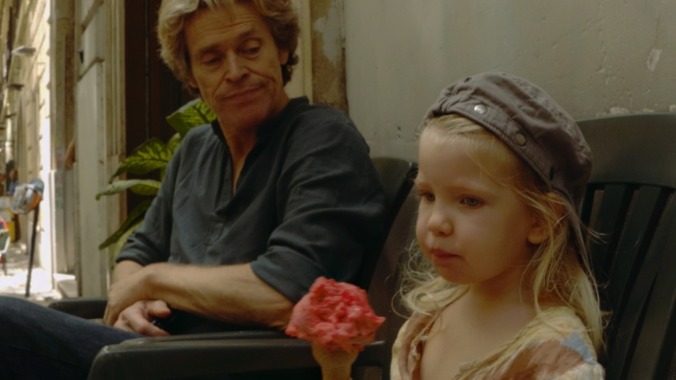Willem Dafoe is an addict trying to keep it together in Abel Ferrara’s disarming Tommaso


About 30 minutes into Abel Ferrara’s Tommaso comes a scene in which the title character, a sixtyish American filmmaker (and blatant Ferrara stand-in) who left New York to make a new life in Rome, sneaks out of his apartment at night. We follow him down a street, then an alley, then a set of stairs. The scene should look very familiar to anyone who has seen one of Ferrara’s gritty, urban portraits of personal hell. But Tommaso (Willem Dafoe) isn’t here to shoot up or score. The sign on the door at the end of the stairs bears the logo of Alcoholics Anonymous. If the moment feels like a self-referential wink to Ferrara’s former bad-boy reputation, it could also be read as an acknowledgement that Tommaso—while nowhere near as grotesquely self-destructive as the nameless cop in Ferrara’s Bad Lieutenant—still has the secrecy of someone with an addiction.
While the AA meeting that follows is the first acknowledgement of Tommaso’s past, it is hardly our first clue, for what we have seen of the character up to now suggests a man bent on keeping himself occupied. He is married to Nikki, a woman half his age, and they have a 3-year-old daughter named Deedee. (They are played, respectively, by Cristina Chiriac and Anna Ferrara, the director’s real-life wife and daughter.) He walks everywhere, takes Italian lessons, teaches an acting class, and cooks, downing espressos and taking swigs of bottled water with reflexes that unmistakably suggest some muscle memory of shots and beer bottles. The rest of his time is spent preparing his next project—which is actually Siberia, the movie that Ferrara filmed after Tommaso.
These scenes, many of which are shot guerilla-style with a camera tracking the busy director through the streets and subways of Rome, are disarmingly sweet, with placid snapshots (going out for gelato, hanging out on the balcony) and moments of near-meditation. Yet Tommaso is a Ferrara movie through and through, running less on dramatic structure than extremes of inner turmoil. In the film’s many fantasy sequences, we initially glimpse insecurities that are ordinary. Tommaso worries that his wife will leave him for a man her own age or that his daughter will be hit by a car while crossing the street. He fantasizes about seeing a barista naked. But slowly, the film reveals the depths of Tommaso’s self-pity.
We witness him imagining himself as a contemporary Christ figure being arrested by the modern Roman police. He may be contemplating an affair with a student with whom he’s become emotionally involved. It’s possible, too, that he’s mixing in details of said student’s life in AA meetings when he’s talking about problems in his marriage. A handful of minor annoyances sets off a final stretch that begs to not be viewed in literal terms, climaxing in bleak violence and a vision of Tommaso being crucified in public. This might constitute another playful reference (in this case, to Dafoe’s role in Martin Scorsese’s The Last Temptation Of Christ) if it weren’t so dark. By this point, we’ve come to understand that Tommaso is an artist who, among many other compulsions, needs people to believe that his self-loathing is self-sacrifice. Whether everything we see on screen is really happening is irrelevant.
Ferrara is, of course, no stranger to spiritual doom, personal demons, or downward spirals; this is a filmmaker who bluntly titled his take on the vampire genre The Addiction, and Tommaso is merely the latest of his movies to center on an alter ego and to draw on his personal history with booze, heroin, and crack. Going down a checklist, one finds many other staples of the Ferrara oeuvre: Christ imagery, lechery, nocturnal perambulations, the focus on an artist’s working life. What sets Tommaso apart are its diaristic qualities, held together by Dafoe’s performance. Ferrara is nothing if not a director who puts a lot of his trust in his actors, and Dafoe (who has made six movies with Ferrara, and is apparently his neighbor in real life) delivers one of his most improvisatory performances. It might even be called a performance of a performance, as Tommaso is first and foremost a raconteur.
Just as important is the fact that Ferrara never cheats his core subject. There’s no scene of Tommaso being tempted by drugs or drink (he is six years sober, and remains so to the end). Ferrara’s underrated 4:44 Last Day On Earth found a simple and touching metaphor for sobriety in its depiction of someone focused on staying clean on the eve of an apocalypse. Tommaso, conversely, reveals another web of needy impulses under the daily effort of sobriety. Like so much in this deceptively earnest film, the Roman backdrop creates ambiguous terms. One is left to wonder whether Tommaso’s internal chaos is that of an eternal figure in an ancient city, or just another guy trying to keep it together as he makes the turn to the Piazza Dante.
Available in virtual theaters June 5.